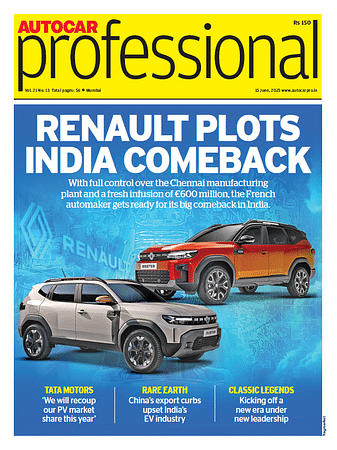Connected Mobility: Redefining the Two-Wheeler Ride
India's two-wheeler industry is embracing digital transformation with Android-powered smart clusters, reshaping rider experiences through connectivity, personalization, and continuous updates—driven by innovations from OEMs, chipset makers, and evolving consumer expectations.
The two-wheeler industry is going through a profound digital revolution. Once limited to a standard odometer, today’s two-wheelers feature instrument clusters with intelligent, connected interfaces that enhance rider engagement, convenience, and safety. This shift—driven by modern operating systems and IoT technologies—parallels the digital reinvention once seen in the four-wheeler market.
India, the world’s largest two-wheeler market, is leading this shift. With over 16.99 million units sold in 2023 and a projected market value of $472.75 billion by 2034, the demand for smarter mobility solutions is accelerating. Android, with its open architecture and scalability, enables OEMs to deliver feature-rich, cloud-connected experiences. From early disruptors like Ather Energy to strategic moves by global players like Qualcomm, let's examine what innovation in this segment means for OEMs, riders, and the future of connected mobility.
Platform Shift: From Smartphones to Smart Rides
Android, which reshaped the smartphone industry, is now becoming a core enabler of connected mobility and a natural choice for two-wheeler applications. As demand for affordable smart features grew, platform providers and chipset makers turned their attention to mobility. However, building for the two-wheeler segment presented unique challenges—cost constraints, simplified user experience, and a balance of reliability and ruggedness.
Chipmakers like Qualcomm and MediaTek responded by creating affordable, reliable platforms that could power these connected experiences. This made it possible for OEMs to bring digital innovation to millions of riders, even in entry- and mid-level vehicles.
Ather’s Disruption: Redefining the Rider Interface
In 2016, Ather Energy revolutionized India's two-wheeler industry by introducing a modern rider interface in its first electric scooter. The vibrant touchscreen cluster enabled real-time navigation, ride analytics, and OTA updates—ushering in a smartphone-like experience and reshaping rider expectations.
Legacy players like Hero MotoCorp, Honda, TVS, and Royal Enfield, along with disruptors like Ola, Okinawa, and Ampere, began prioritizing digital cluster innovation. Ather’s pioneering success in connected mobility paved the way for widespread adoption.
From Legacy Components to Strategic Interfaces
Ather’s disruption delivered a clear message: the future of mobility is digital and rider-centric. OEMs quickly recognized that the instrument cluster was no longer a peripheral element but a strategic interface and key brand differentiator. By integrating diagnostics, infotainment, and navigation into a single, cohesive display, manufacturers are building platforms for deeper engagement, post-sale services, and data monetization.
This transition has been fueled by consumer expectations. India’s growing digital literacy and smartphone penetration have created a baseline for what riders want: Bluetooth connectivity, turn-by-turn navigation, ride statistics, and seamless OTA updates. OEMs began differentiating based on digital experience, turning clusters into brand signatures and enablers of customer engagement, data-driven services, and post-sale monetization.
In FY2024, Hero MotoCorp sold approximately 5.62 million units, Honda 4.89 million, and TVS 3.56 million two-wheelers, highlighting the vast market undergoing digital transformation.
Making Smart Clusters Scalable
The rising demand for digital clusters created an urgent need for scalable, cost-effective hardware. Qualcomm introduced QCW2290—a value-tier IoT chipset purpose-built for two-wheeler clusters. This marked a strategic expansion of Qualcomm’s mobility portfolio, bringing efficient and purpose-built compute to an underserved segment.
Offering essential compute, low power consumption, and reliable connectivity, the QCW2290 enabled Android-powered experiences such as navigation, Bluetooth, and cloud integration without the expense of premium silicon.
One challenge: it lacked a native Controller Area Network (CAN) interface, essential for in-vehicle communications. Qualcomm innovatively addressed this through an external microcontroller, streamlining vehicle communication and accelerating time to market.
Beyond Android: Toward a Software-Defined Two-Wheeler
While Android remains a key enabler—thanks to its open architecture and developer ecosystem—the real transformation lies in how software platforms now orchestrate the entire vehicle-cloud-mobile experience.
Today’s connected clusters are no longer static displays. They form part of a dynamic, software-defined vehicle architecture, where new capabilities, UI enhancements, and diagnostics can be delivered and refined long after the vehicle leaves the showroom.
This shift is ushering in a new product mindset: one where OEMs deliver ongoing value through updates, integrations, and personalized rider services over the lifecycle of the vehicle.
The Road Ahead: Intelligent, Personalized, and Connected
As digital clusters become the norm, the next wave will be intelligent, context-aware, and deeply personalized rider experiences, and will include:
- Hyper-personalization of the display interface and alerts
- V2X connectivity for collision warnings and smart routing
- Continuous OTA updates for feature enhancements and security patches
- Ecosystem Sync: Integration with mobile apps, wearables, and smart homes
Today, delivering connected, personalized, and continually evolving rider experiences is essential for sustained growth and leadership. As OEMs and technology providers align around a shared vision, we are entering an era where every ride offers a digitally immersive experience.
The connected instrument cluster is now the bridge between rider and machine, brand and the user.
Harish Haswani is Associate Vice President at CDPP-iSquare Mobility, Innominds. Views expressed are the author's personal.
RELATED ARTICLES
Opinion: Three must dos for Nissan's rebirth in India
Nissan needs to treat its future plans as a re-entry and not a new phase.
Why Time Is the New Currency in India’s Commercial EV Revolution
India’s commercial EV revolution hinges not just on sustainability or innovation, but on time—maximizing uptime, minimiz...
The Growth of the Second-hand/Refurbished Bike Market in India
As rising costs and changing mindsets reshape mobility, India’s used two-wheeler market is gaining momentum—driven by af...





 26 Jun 2025
26 Jun 2025
 188 Views
188 Views





 Autocar India
Autocar India


 Sarthak Mahajan
Sarthak Mahajan


